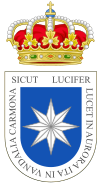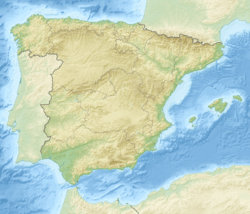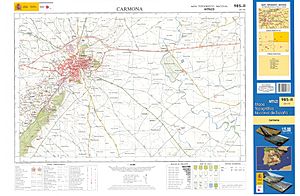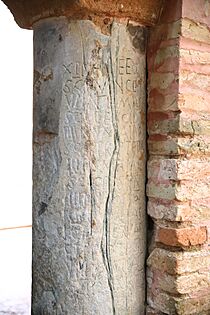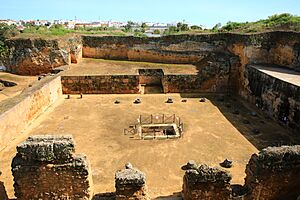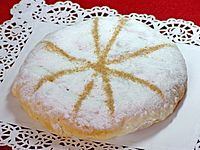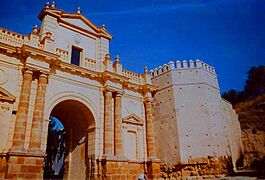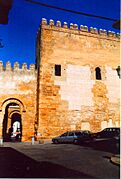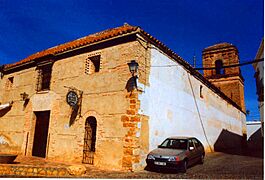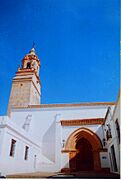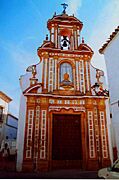Carmona, Spain facts for kids
Quick facts for kids
Carmona
|
|||
|---|---|---|---|
 |
|||
|
|||
| Country | Spain | ||
| Autonomous community | Andalusia | ||
| Province | Seville | ||
| Area | |||
| • Total | 924.12 km2 (356.80 sq mi) | ||
| Elevation | 253 m (830 ft) | ||
| Population
(2018)
|
|||
| • Total | 28,620 | ||
| • Density | 30.970/km2 (80.212/sq mi) | ||
| Demonym(s) | Carmonense or Carmonés | ||
| Time zone | UTC+1 (CET) | ||
| • Summer (DST) | UTC+2 (CEST) | ||
| Postal code |
41410
|
||
Carmona is a historic town in southwestern Spain. It is located in the province of Seville, about 33 kilometers (20 miles) northeast of the city of Seville.
Carmona is built on a high ridge. From here, it looks over the flat central plain of Andalusia. To the north, you can see the Sierra Morena mountains. To the south, there is the peak of San Cristobal. The town is known for its trade in wine, olive oil, grain, and cattle. It also hosts a fun annual fair every April.
Contents
Geography of Carmona
Where is Carmona?
Carmona is in the southwest part of the Iberian Peninsula. It sits about 249 meters (817 feet) above sea level. The town is on a ridge that runs from northeast to southwest. This ridge is at the end of the Los Alcores tableland. From here, it overlooks the green fields of the Corbonés river. This river flows into the Guadalquivir river.
Carmona's Climate
Carmona has a Mediterranean climate. This means it has sunny springs with some rain. In October, the temperature usually ranges from 13°C (55°F) to 26°C (79°F). The town gets a moderate amount of rain each year. Winters in Carmona are usually mild and pleasant.
History of Carmona
Carmona started as a settlement of the Tartessos and Turdetani people. Later, Phoenician traders from Tyre arrived. They turned Carmona into a city called Qrt-Ḥmn, which meant "City of Hammon".
Centuries later, Carmona became an important Roman stronghold. It was known as Carmo during the time of Julius Caesar. The city was made even stronger during the long rule of the Moors. They built thick walls around it and added fountains and palaces inside.
After the Caliphate of Córdoba ended in the early 11th century, Carmona was taken by different groups. It became the capital of a small kingdom called the taifa of Carmona. This kingdom was later conquered by the taifa of Seville. Carmona was an Almoravid stronghold and then controlled by the Almohads.
In 1247, Ferdinand III of Castile captured the town. He gave it a special Latin motto. It said, "As the Morning-star shines in the Dawn, so shines Carmona in Andalusia." For a long time, most people in Carmona were Muslim, but they were ruled by a Christian minority.
The citadel of Carmona, which is now in ruins, was a main fortress for Peter the Cruel. It had a large palace inside its defenses. By the late 1400s, Carmona had about 8,000 people. In later centuries, Carmona's economy was mostly based on farming.
Ancient Wine Discovery
In June 2024, something amazing was found in Carmona. Researchers from the University of Cordoba announced the discovery of 2,000-year-old white wine. It was found in a glass urn inside a tomb. The tomb also held the bones of two men named Hispana and Senicio. There were also bones of two other men and two women who were not named.
Scientists noted that the tomb was very well preserved. It was protected from floods and leaks for thousands of years. This amazing preservation allowed the wine to stay in its original state.
Main Sights to See
Carmona has many interesting historical places to visit.
- Palace of King Don Pedro: This palace was built in the 13th century by Peter I of Castile. An earthquake damaged it in 1504.
- Moorish alcázar: A fortress built by the Moors.
- Palace of Rueda
- Palace of the Marquess of Torres
- Seville Gate Palace
- Baroque palaces: You can see beautiful old palaces like those of Alonso Bernal Escamilla, Aguilar, Domínguez, and Lasso.
- Córdoba Gate: This gate was on the road to Córdoba. Parts of it were built by the Romans.
- Seville Gate: This gate has Carthaginian origins. It also has parts added by the Romans and was changed by the Moors and Christians.
- Marchena Gate: Built when the Almohads ruled Spain.
- Roman Bridge
- Remains of the Via Augusta: Parts of an ancient Roman road.
- Tree-lined avenue of Alfonso XIII
- Roman Necropolis: This ancient burial ground was found in 1881. It is near the town, by the road to Seville. It has over 900 family tombs from 200 BC to 400 AD. These tombs are underground rooms carved from rock. They often have paintings on the walls. Many still have the funeral urns inside. Some larger tombs have waiting areas with stone benches for funeral parties. Some even have carved family symbols.
- The Tomb of the Elephant and the Tomb of Servilia are two famous tombs in the necropolis.
- Roman Amphitheatre: Also discovered in 1881, this ancient arena is near the necropolis. It dates from the first four centuries AD.
- Ayuntamiento (Town Hall)
- Cave of the Batida
- Fountain of the Lions
- Hospital of the Mercy and the Charity Church of Saint Bartholomew
- Tower of the Peak
- Market
- Cerezo Theatre
Religious Buildings
Carmona has many beautiful churches and convents.
- Church of San Pedro: Built in the 15th century. Its bell tower looks like a smaller version of the famous Giralda tower in Seville.
- Church of Santa Maria de la Asunción
- Church of El Salvador: A Baroque style church from the 17th century.
- Church of the Convent of Santa Ana
- Church of San Blas
- Church of San Felipe: From the 14th century.
- Church of Santiago
- Convent of the Immaculate Conception
- Convent of the Trinity
- Convent of Las Descalzas: Home to Discalced Carmelite Nuns.
- Convent of Santa Clara: A 15th-century convent with a Mudéjar church. It was updated in 1664 in Baroque style.
- Hermitage of San Mateo: From the 15th century.
- Hermitage of Our Lady of Real or San Antón: Also from the 15th century.
- Ermita de la Virgen de Gracia: This is dedicated to Our Lady of Grace, who is the patron saint of Carmona.
Carmona's Food
Carmona's restaurants and bars offer a wide range of Spanish food. You can find delicious tapas and other traditional dishes. The town is famous for its traditional Andalusian cooking. There's even a special "Tapas Route" (Ruta de las tapas). This route guides you to different bars and is marked with blue and white signs.
Typical Dishes
Some common Carmonan dishes include:
- Sopa de picadillo: A tasty chicken soup.
- Pringá: A mix of meats and sausages, often served with bread.
- Chickpeas
- Snails
- Salmorejo: A thick, cold tomato soup.
- Spinach
- Tagarnina: A type of thistle used in cooking.
- Serrano ham
- Partridge: A type of bird from the mountains.
- Gazpacho: Another popular cold soup.
- Chickpea soup
- Tomato soup
- Potatoes
- Cuajados: A dish made with curdled eggs.
Sweet Treats
For dessert, try these Carmonan sweets:
- Torta inglesa: A traditional cake.
- Hojaldres: Delicious puff pastries.
- Rice with milk
- Torrija: Fried toasted bread soaked in wine, milk, or honey.
- Polvorónes: Shortbread cookies.
- Almond cakes
- Chestnut stew with cinnamon
- Porridge sprinkled with cinnamon
- Cortadillos: Sweet little cakes.
Many of these desserts are made by the nuns in the city's convents, especially at Santa Clara.
Drinks
A common alcoholic drink is Anise Los Hermanos. This drink is made and bottled right in Carmona. It comes in three types: crisp, sweet, and semi-dry.
Carmona in Films
Carmona has a rich history and beautiful buildings. This gives the city a special look and feel. Because of this, Carmona has been the setting for many films. It continues to attract movie crews from all over. The Location Managers Guild of America, a group that helps find filming spots for movies and TV shows from the United States, is very interested in Carmona's city center.
Gallery
Notable People from Carmona
Many interesting people have connections to Carmona:
- Rodrigo González de Marmolejo (1487–1564): A Catholic leader and the first Bishop of Santiago de Chile.
- Antón García Caro (1560 - around 1624): A Spanish lawyer and politician.
- Manuel Freire de Andrade (1767–1835): A Spanish cavalry officer.
- Tomás Domínguez Romera (1848–1931): A Spanish noble, landowner, and politician.
- José Arpa (1858–1952): An artist who worked in Spain, Mexico, and Texas.
- Michael Denzil Xavier Portillo (born 1953): A British journalist, TV presenter, and former politician. He lives in Carmona.
- Félix Gómez (born 1977): A Spanish actor.
See also
 In Spanish: Carmona para niños
In Spanish: Carmona para niños



